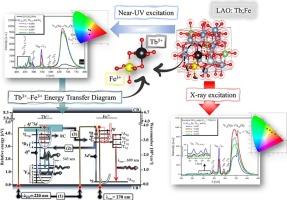Tb3+/Fe3+共掺杂LiAl5O8在紫外和x射线激发下的可调谐可见光
IF 3.6
3区 物理与天体物理
Q2 OPTICS
引用次数: 0
摘要
在这项工作中,我们报道了Tb3+和Fe3+离子共掺杂LiAl5O8的合成和光学特性,旨在研究不同激发条件下的可调谐可见光。以葡萄糖为螯合剂,采用溶胶-凝胶法制备样品。在215 nm和270 nm的紫外激发下分析了光致发光(PL)响应,在Tb3+ (7520 eV)的liii边缘激发下研究了x射线激发光学发光(XEOL)。结果表明,共掺杂可以有效地控制发射颜色,Tb3+和Fe3+离子分别贡献绿色和红色,证实了Fe3+作为共掺杂体系中可调谐发光应用的红色发射中心的潜力。色度坐标(x, y)和相关色温(Tp)的演变使用CIE 1931图进行评估。在215 nm激发下,发射色调从暖白色到橙色,表明白光发光二极管(WLED)应用的潜力,在7520 eV激发下,从绿色转变为强烈的红色。这些发现表明,所有样品在近紫外和x射线激发下都表现出可见的发光,证实了它们在固态照明器件和闪烁体材料中的应用潜力。本文章由计算机程序翻译,如有差异,请以英文原文为准。

Tunable visible luminescence from Tb3+/Fe3+ co-doped LiAl5O8 under UV and X-ray excitation
In this work, we report the synthesis and optical characterization of LiAl5O8 co-doped with Tb3+ and Fe3+ ions, aiming to investigate tunable visible luminescence under different excitation conditions. The samples were prepared using the sol-gel method, with glucose as the chelating agent. Photoluminescence (PL) responses were analyzed under ultraviolet excitation at 215 nm and 270 nm, while X-ray-excited optical luminescence (XEOL) was investigated under excitation at the L-edge of Tb3+ (7520 eV). The results show that co-doping enables effective control of the emission color, with green and red contributions from Tb3+ and Fe3+ ions, respectively, confirming the potential of Fe3+ as a red-emitting center in co-doped systems for tunable luminescence applications. The evolution of chromaticity coordinates (x, y) and correlated color temperature () was evaluated using CIE 1931 diagrams. Emission tones ranged from warm white to orange under 215 nm excitation, indicating potential for white light-emitting diode (WLED) applications, and shifted from green to intense red under 7520 eV excitation. These findings demonstrate that all samples exhibit visible luminescence under both near-ultraviolet and X-ray excitation, confirming their potential for application in solid-state lighting devices and scintillator materials.
求助全文
通过发布文献求助,成功后即可免费获取论文全文。
去求助
来源期刊

Journal of Luminescence
物理-光学
CiteScore
6.70
自引率
13.90%
发文量
850
审稿时长
3.8 months
期刊介绍:
The purpose of the Journal of Luminescence is to provide a means of communication between scientists in different disciplines who share a common interest in the electronic excited states of molecular, ionic and covalent systems, whether crystalline, amorphous, or liquid.
We invite original papers and reviews on such subjects as: exciton and polariton dynamics, dynamics of localized excited states, energy and charge transport in ordered and disordered systems, radiative and non-radiative recombination, relaxation processes, vibronic interactions in electronic excited states, photochemistry in condensed systems, excited state resonance, double resonance, spin dynamics, selective excitation spectroscopy, hole burning, coherent processes in excited states, (e.g. coherent optical transients, photon echoes, transient gratings), multiphoton processes, optical bistability, photochromism, and new techniques for the study of excited states. This list is not intended to be exhaustive. Papers in the traditional areas of optical spectroscopy (absorption, MCD, luminescence, Raman scattering) are welcome. Papers on applications (phosphors, scintillators, electro- and cathodo-luminescence, radiography, bioimaging, solar energy, energy conversion, etc.) are also welcome if they present results of scientific, rather than only technological interest. However, papers containing purely theoretical results, not related to phenomena in the excited states, as well as papers using luminescence spectroscopy to perform routine analytical chemistry or biochemistry procedures, are outside the scope of the journal. Some exceptions will be possible at the discretion of the editors.
 求助内容:
求助内容: 应助结果提醒方式:
应助结果提醒方式:


